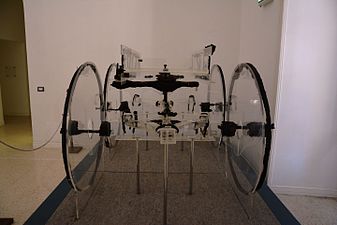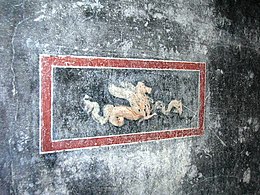Stabiae
 Wall painting from Stabiae, 1st century AD | |
| Location | Castellammare di Stabia, Province of Naples, Campania, Italy |
|---|---|
| Region | Magna Graecia |
| Coordinates | 40°42′11″N 14°29′57″E / 40.702952°N 14.499259°E / 40.702952; 14.499259Coordinates: 40°42′11″N 14°29′57″E / 40.702952°N 14.499259°E / 40.702952; 14.499259 |
| Type | Settlement |
| Site notes | |
| Management | Soprintendenza Speciale per i Beni Archeologici di Pompei, Ercolano e Stabia |
| Website | Sito Archeologico di Stabiae (in Italian) (in English) |
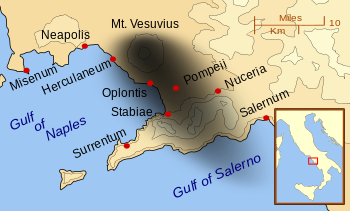
Stabiae and other cities affected by the eruption of Mount Vesuvius. The black cloud represents the general distribution of ash and cinder. Modern coast lines are shown.
Stabiae was an ancient Roman town near the modern town of Castellammare di Stabia and approximately 4.5 km southwest of Pompeii, which became famous for the magnificent Roman villas found there in recent times. The beautiful objects and frescoes taken from these villas were often sold and distributed, while many can be found in the National Archaeological Museum of Naples.
The villas were sited on a 50 m high headland overlooking the Gulf of Naples.[1][2] Being only 16 kilometres (9.9 mi) from Mount Vesuvius, this seaside resort was largely buried by two metres of tephra ash in 79 AD.
Contents
1 History
1.1 Pre-Roman settlement
1.2 Roman Period
2 Archaeology
3 Villas
3.1 Villa San Marco
3.1.1 Gallery
3.2 Villa Arianna
3.2.1 Gallery
3.3 The Second Complex
3.3.1 Gallery
3.4 Villa del Pastore
3.5 Villa of Anteros and Heraclo
4 See also
5 References
6 External links
History
Pre-Roman settlement

City gate of Stabiae
That the favourable climate had attracted settlements in the area from as early as the 7th century BC is evocatively documented by materials found in the vast necropolis discovered in 1957 on via Madonna delle Grazie situated between Gragnano and Santa Maria la Carità, which show the strategic and commercial significance of Stabiae in the Archaic period. The necropolis of over 300 tombs containing imported pottery of Corinthian, Etruscan, Chalcidian and Attic origin clearly shows that the town had major commercial contacts.[3] The necropolis, covering an area of 15,000m2, was used from the 7th to the end of the 3rd century BC and shows the complex population changes with the arrival of new peoples, such as the Etruscans, which opened up new contacts.[4]
Stabiae had a small port which by the 6th c. BC had already been overshadowed by the much larger port at Pompeii. It later became an Oscan settlement[5] and it appears that the Samnites later took over the Oscan town in the 5th century.[6]
With the arrival of the Samnites the city suffered a sudden social and economic slowdown in favour of the development of nearby Pompeii, as shown by the almost total absence of burials: however, when the influence of the Samnites became more marked in the middle of 4th century BC Stabiae began a slow recovery,[7] so much so that it was necessary to build two new necropoles, one discovered in 1932 near the Mediaeval Castle, the other in Scanzano. A sanctuary, probably dedicated to Athena, was built in the locality of Privati.[8]
It then became part of the Nucerian federation, adopting its political and administrative structure and becoming its military port, although it enjoyed less autonomy than Pompeii, Herculaneum and Sorrento; in 308 BC, after a long siege, it was forced to surrender in the Samnite wars against the Romans.
The settlement of Stabiae is still to be clearly identified but was most probably an oppidum, or fortified town, of some importance owing to the fact that when conflict with the Romans reached a head during the Social War (91–88 BC), the Roman general Sulla did not simply occupy the town on 30th April 89 BC but destroyed it. Its location is said to be delimited by the Scanzano gorge and the San Marco stream which partly eroded its walls.
Roman Period

Map of excavations at Stabiae
The earliest Roman evidence is coins from Rome and Ebusus found in the sanctuary of Privati dating back to the 3rd c. BC probably brought in by merchants.[9] During the Punic Wars Stabiae supported Rome against the Carthaginians with young men in the fleet of Marcus Claudius Marcellus, according to Silius Italicus who wrote:
Irrumpit Cumana ratis, quam Corbulo ducato lectaque complebat Stabiarum litore pubes.
The Roman author and admiral Pliny the Elder recorded that the town was rebuilt after the Social Wars and became a popular resort for wealthy Romans. He reported that there were several miles of luxury villas built along the edge of the headland, all enjoying panoramic views out over the bay.[2]
In the plain around Stabiae was the Ager Stabianus, an agricultural territory in which about 50 rural villas (villae rusticae) have been identified for the production and processing of agricultural products with wine and olive presses, threshing floors and storehouses,[10] ranging from 400 to 800 sqm floor areas where intensive agriculture exploiting the fertility of the soil made the owners wealthy, considering the villas' beneficial parts including warehouses, thermal baths and frescoed rooms.
Stabiae was also well known for the quality of its spring water, which was believed to have medicinal properties.[11]
According to the account[12] written by his nephew, Pliny the Elder was at the other side of the bay in Misenum when the eruption of 79 AD started. He sailed by galley across the bay, partly to observe the eruption more closely, and partly to rescue people from the coast near the volcano.
Pliny died at Stabiae the following day, probably during the arrival of the sixth and largest pyroclastic surge of the eruption caused by the collapse of the eruption plume.[13] The very diluted outer edge of this surge reached Stabiae and left two centimetres of fine ash on top of the immensely thick aerially-deposited tephra which further protected the underlying remains.
However the eruption did not completely end human activity as about 40 years later the road to Nuceria was rebuilt as its 11th milestone recovered from the cathedral site shows. Also a poem from Publius Papinius Statius (c. 45 - c. 96 AD) asked his wife to join him in what he called “Stabias renatas” (Stabiae reborn).[14] In the 2nd c. AD new necropoleis were created at Grotta S.Biagio (below the Villa Arianna), Santa Maria la Carità and Pimonte.
Archaeology

Famous Spring fresco from the Villa Arianna, Stabiae
The most famous of the finds at Stabiae are the villas that come from the time between the destruction of Stabiae by Sulla in 89 BC and the eruption of Mount Vesuvius in 79 AD.[5] These provide us with some of the most stunning architectural and artistic remains from any Roman villas.
The archaeological remains of Stabiae were originally discovered in 1749 by Cavaliere Rocco de Alcubierre, an engineer working for king Charles VII of Naples.[15] These ruins were partially excavated by Alcubierre with help from Karl Weber between 1749–1782.[15] In 1759 Weber partially identified and described part of the old city that extended over an area of about 45000 sqm.
The ruins that had been excavated, however, were reburied and their location was forgotten until 1950[2] when Libero D'Orsi brought to light parts of a residential area about 300 m from Villa San Marco including remains of houses, shops, parts of the macellum [16] to which roads from the port converged.[17] These remains were again reburied and the only visible evidence of the ancient village is a gate located next to the Villa San Marco.
The site was declared an archaeological protected area in 1957, and by 1962 many of the ruins had been again uncovered. The remains of both an Oscan settlement (oppidum) and the later Roman town were discovered.
2004 saw an Italian-American collaboration between the Superintendency of Archaeology of Pompeii, the region of Campania and the University of Maryland to form the non-profit Restoring Ancient Stabiae Foundation (RAS) whose prime goal was to excavate, restore and build an archaeological park there.[18]
In 2008 Villa San Marco and Villa Arianna were re-explored and in the first villa a series of rooms, two latrines and a garden were brought to light, while in the second part of the great peristyle that looked directly over the sea was discovered.
In 2009 new excavations brought to light a Roman road running along the northern perimeter of Villa San Marco. It is a cobbled road that connected the village of Stabia with the underlying shore: across this artery is a gate to the city and along the walls are a myriad of graffiti and small drawings in charcoal. On the other side of the road a baths area of a new villa was discovered, partly explored in the Bourbon era. A Roman road also led to the entrance of a domus belonging to the "Ager stabianus". In May 2010 a villa dating to the first century was discovered during the work to double the railway track of the Torre Annunziata-Sorrento line of the Circumvesuviana, between the stations of Ponte Persica and Pioppaino.
Villas

Atrium, Villa San Marco
Among the many villas found at Stabiae are firstly large leisure villas (villa otium) without agricultural buildings such as:
- Villa San Marco
- Villa Arianna
- the Second Complex,
- Villa Del Pastore
- Villa of Anteros and Heraclo
and secondly residential villas with agricultural sections (villa rustica) such as:
- Villa del Petraro
- Villa Carmiano
- Villa Sant'Antonio Abate
- Villa Medici
- Villa Petrellune
- Ogliaro Villas
- Villa of the Philosopher
- Villa Casa dei Miri
- Villa Sassole

Plan of Villa San Marco
Villa San Marco

Entrance to Villa San Marco and atrium
This villa derived its name from a nearby chapel that existed in the 18th century, was the first to be explored in the excavations in Bourbon times between 1749 and 1754. The documentation of the Bourbon surveys was published in 1881 by M. Ruggiero M. in the book Degli Scavi di Stabiae dal 1749 al 1782 ("On the Stabiae excavations from 1749 to 1782"). The villa was re-buried after the removal of its furnishings and of the better preserved frescoes. Excavations were resumed in 1950 by Libero d’Orsi and O. Elia of the Archaeological Superintendency.[19]
One of the largest villas ever discovered in Campania it measured more than 11,000 sq. m,[2] although only half has been excavated. It has an atrium containing a pool, a triclinium with views of the bay, and a colonnaded courtyard. There are also many other small rooms, a kitchen and two internal gardens. This villa is also important because it has provided frescoes, sculptures, mosaics and architecture, which show styles and themes comparable to those found in Pompeii and Herculaneum.

Kitchen, Villa San Marco
The great peristyle is surrounded by a long porch with a central pool of 36x7 m which at the end has a nympheum that has yet to be explored, decorated with frescoes depicting Neptune, Venus and several athletes, that were removed by the Bourbons and is now at the Naples museum and the Condé Museum in Chantilly, France. In the peristyle garden plane trees were present at the time of the eruption whose root cavities were found; just as with the casts of humans these cavities were filled with liquid concrete to make casts and archaeologists have also calculated that at the time of the eruption the age of these trees ranged from 75 to 100 years.
The villa has a second peristyle on the southern side, approximately 140m long, with arcades supported by spiral columns which collapsed during the 1980 Irpinia earthquake: the ceiling is painted with scenes depicting Melpomene and the Apotheosis of Athena etc. In this peristyle was a sundial found during the excavation in a deposit as the villa at the time of the eruption was under renovation; the sundial was subsequently placed in its original position.
The baths of the villa are of considerable size on a triangular plot. The remains of the frescoes show it was finely decorated with depictions of large pendulous branches. Access to the spa area is via an atrium, painted with wrestlers and boxers, followed by apodyterium, tepidarium, frigidarium, palaestra and caldarium: the pool in the caldarium, which is accessible by stone steps, is 7x5m and 1.5m deep. In excavations in the pool, part of the bottom was removed exposing a large brick furnace heating a large bronze boiler which was removed in 1798 by Lord Hamilton to be transported to London, but during the trip the Colossus was shipwrecked. The caldarium was covered with marble slabs. From the baths there are a number of ramps connecting the villa with the flat area close to the sea.
Gallery
Villa Arianna

Map of Villa Arianna and the Second Complex on the left

Villa Arianna
Named for the fresco depicting Dionysus saving Ariadne from the island of Dia (a mythological name for Naxos), this villa is particularly famous for its frescoes, many of which depict light, winged figures. The villa expanded over the course of 150 years. It has one of the largest courtyards of any Roman villa; measuring two stadia in length. Another feature is its private tunnel system that links the villa in its location on the ridge to the sea shore, which was probably only between 100 and 200 metres away from the bottom of the hill in Roman times. The shoreline has since changed, leaving the site further inland than it was in antiquity.
Gallery
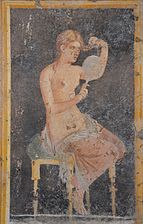
Fresco, Villa Arianna, Naples Museum
Roman carriage (Villa Arianna)

Fresco, Villa Arianna, Naples Museum

Fresco, Villa Arianna, Naples Museum

Villa Arianna
The Second Complex

Portico, Second Complex
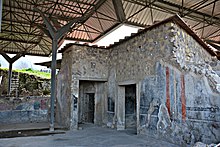
The Second Complex is a villa otium located on the edge of the Varano hill between the Villa del Pastore and Villa Arianna and separated by a narrow alley from the latter. The site was explored for the first time in 1762 by Karl Weber, in 1775 by Peter la Vega and finally in 1967 by Libero D'Orsi: only about 1000 sq. m has been brought to light and access is via Villa Arianna, which because of its proximity is often confused as the same villa.
The villa consists of two areas, the oldest around the peristyle which was built around the first century BC and the later part, probably widening or merging of an existing structure, dating back to the imperial age. The peristyle has a portico on three sides and different areas including a oecus (lost following a landslide), and several scenic areas that looked out on the sea. On the west side there is a square fish pond with lead pipes and water spouts. The south side is a pseudo-portico adorned with columns resting on a wall, behind which lies the baths that includes a caldarium with a bathtub, a tepidarium also with tub and garden and a laconicum with domed roof and a kitchen. On the north side next to Ariana Villa are a triclinium, a cubiculum.
Most of the villa's objects were taken away by the Bourbons, as well as part of the black and white geometric tessellated pavement; however the black walls in the third style are well preserved.
Gallery
Villa del Pastore

Shepherd from the Villa del Pastore
"Villa of the Shepherd" in English, this villa gets its name from a small statue of a shepherd that was discovered at this site.
The villa stands on the edge of the plateau Varano with a panoramic view, a short distance from Villa Arianna. It was explored three times: its discovery dates back to 1754 to 1759 when Karl Weber brought to light a large garden; the second campaign under Peter la Vega was carried out between 1775 and 1778; the third and final exploration dates to 1967-8 when the villa was rediscovered following the discovery of a perimeter wall after removal of a layer of lapilli on agricultural land. This excavation was funded by the landowner and the superintendent of the time tried to expropriate church land in the area between Villa Arianna and Villa San Marco in order to combine the areas of the villas of Stabiae. While waiting for the permit, the villa was re-buried in 1970 to prevent it from ruin. As a result of various bureaucratic problems related to the cause of expropriation, the villa remains buried and has not yet been fully excavated.[20]
The villa is even larger than Villa San Marco at 19,000 square metres and includes many rooms, large baths and luxurious gardens. It lacks, however, any domestic rooms suggesting that it may not have been a residence. One hypothesis is that it is instead a valetudinarium (health spa) to allow people to take advantage of the famous spring waters of Stabiae.

Labrum from Villa del Pastore
The Villa del Pastore dates from between the eighth century BC and 79 AD. It is divided into two parts: a large outdoor area and a series of residential rooms. The garden area is bordered to the south by the semicircular wall, while on the north is a 140m long cryptoporticus which runs parallel to a colonnade on a slightly lower level. At the centre of the garden is a swimming pool (natatio) with marble staircase. In the centre of the semicircular alcove was found the statue that gives the villa its name, of marble, 65 cm tall in Hellenistic style and is an old shepherd dressed in hides, carrying on his shoulders a kid, with a basket with grapes and bread on his left hand while in the right hand is a hare. Also in the garden to the south west is a porch 10x2m portico paved with black and white mosaic. Also a small square nympheum was found in the centre of which was placed a marble labrum.
The second part of the villa has fifteen rooms around a central courtyard, on the north side of which lies the baths area in which is located an apodyterium, a steam bath, a kitchen and a vestibule.
The villa is spread over three levels shown as a result of recent landslides, and a number of substructures which had the dual function of containment of the hill and the villa's support base have been revealed; like the other villas nearby, this villa was directly connected to the sea by a series of ramps that sloped down toward the beach.
Villa of Anteros and Heraclo
The villa of Anteros and Heraclo (also called Villa del Fauno or Villa Chapel San Marco) is a villa otium situated on the border between Castellammare di Stabia and Gragnano, a few metres from Villa San Marco and on the Varano plateau.[21] It was explored for the first time by Karl Weber in 1749 and is one of the first Roman remains found during the Bourbon excavations of the ancient town. After being investigated and plundered of all items considered of value it was left buried.
Archaeologists were not able to locate the site until 2006 when a group of volunteers involved in the work of clearing the Varano ridge witnessed a landslide: continuing to dig they brought to light various structures, including a doorway and the hinge of a door. After the initial enthusiasm and initiatives to recover the remains, lack of funds has led to villa becoming overgrown again.
Not much is known of the villa apart from the descriptions of the Bourbons: this is probably the only building in the area to belong to judges, as evidenced by the discovery of a large number of scales and coins, sometimes in gold, and a plaque about 1.5m wide written in red letters that read:
"ANTEROS HERACLIO SUMMAR MAG" (Anteros Heraclio chief magistrate)
It is not known if this is the name of one or two judges, but it is known that they had the tasks to keep the documents of the village, collect taxes and organise festivals. In addition to this license plate were found a bust of a woman which some scholars have identified as Livia, with curly hair adorned with a brooch, and also a cameo depicting a woman, perhaps Venus, who holds a branch.
See also
- Aeclanum
- Herculaneum
- Oplonti
- Pliny the Elder
- Pliny the Younger
- Pompeii
- Stabia
References
^
San Diego Museum of Art exhibition on Stabiae Archived 10 February 2006 at the Wayback Machine.
^ abcd Restoring Stabiae website
^ http://www.pompeiisites.org/Sezione.jsp?titolo=%E2%80%9CIn+Search+of+Stabiae%E2%80%9D&idSezione=7766
^ http://www.pompeiisites.org/Sezione.jsp?titolo=History+of+Stabiae&idSezione=3386
^ ab
Felice Senatore (2003). Stabiae: Dalla preistoria alla guerra greco-gotica. Edizioni Spano. ISBN 88-88226-15-X..mw-parser-output cite.citation{font-style:inherit}.mw-parser-output q{quotes:"""""""'""'"}.mw-parser-output code.cs1-code{color:inherit;background:inherit;border:inherit;padding:inherit}.mw-parser-output .cs1-lock-free a{background:url("//upload.wikimedia.org/wikipedia/commons/thumb/6/65/Lock-green.svg/9px-Lock-green.svg.png")no-repeat;background-position:right .1em center}.mw-parser-output .cs1-lock-limited a,.mw-parser-output .cs1-lock-registration a{background:url("//upload.wikimedia.org/wikipedia/commons/thumb/d/d6/Lock-gray-alt-2.svg/9px-Lock-gray-alt-2.svg.png")no-repeat;background-position:right .1em center}.mw-parser-output .cs1-lock-subscription a{background:url("//upload.wikimedia.org/wikipedia/commons/thumb/a/aa/Lock-red-alt-2.svg/9px-Lock-red-alt-2.svg.png")no-repeat;background-position:right .1em center}.mw-parser-output .cs1-subscription,.mw-parser-output .cs1-registration{color:#555}.mw-parser-output .cs1-subscription span,.mw-parser-output .cs1-registration span{border-bottom:1px dotted;cursor:help}.mw-parser-output .cs1-hidden-error{display:none;font-size:100%}.mw-parser-output .cs1-visible-error{font-size:100%}.mw-parser-output .cs1-subscription,.mw-parser-output .cs1-registration,.mw-parser-output .cs1-format{font-size:95%}.mw-parser-output .cs1-kern-left,.mw-parser-output .cs1-kern-wl-left{padding-left:0.2em}.mw-parser-output .cs1-kern-right,.mw-parser-output .cs1-kern-wl-right{padding-right:0.2em}
^
Encyclopædia Britannica Website
^ Giovanna Bonifacio and Anna Maria Sodo, Stabia: history and architecture: p. 13. 250th anniversary of the Stabiae excavations 1749-1999, Rome, The Hermes of Bretschneider, 2004,
ISBN 978-88-826-5201-2 .
^ Giovanna Bonifacio, Anna Maria Sodo and Gina Carla Ascione, In Stabiano - Culture and Archeology from Stabiae , Castellammare di Stabia, p.16. Longobardi Editore, 2006,
ISBN 88-8090-126-5
^ Giovanna Bonifacio, Anna Maria Sodo and Gina Carla Ascione, In Stabiano - Culture and Archeology from Stabiae , Castellammare di Stabia, Longobardi Editore, 2006,
ISBN 88-8090-126-5 . p.16
^ Giuseppe Cosenza, Stabia , Trani, Tipografica Editrice Vecchi, 1907.
^ Encyclopædia Britannica Website
^ Account of Pliny's death (the famous letter by Pliny's nephew, Pliny the Younger, in Latin and English)
^
Francis, Peter & Oppenheimer, Clive (2004). Volcanoes. Oxford University Press. ISBN 0-19-925469-9.
^ Statius, Silvae 3.5: Ad Uxorem Claudiam
^ ab
Parslow, Christopher Charles (1995). Rediscovering Antiquity: Karl Weber and the Excavation of Herculaneum, Pompeii, and Stabiae. Cambridge University Press. ISBN 0-521-47150-8.
^ Arnold De Vos; Mariette De Vos, Pompeii, Herculaneum, Stabia , Rome, Editori Laterza, 1982. p. 323
^ Giuseppe Di Massa, the territory of Gragnano in antiquity and the ager stabianus, pp. 1-48. http://www.centroculturalegragnano.it/wp-content/uploads/2016/03/Il-Territorio-di-Gragnano-nell%E2%80%99antichit%C3%A0-e-l%E2%80%99Ager-Stabianus.pdf
^ http://www.stabiae.org/foundation/en/
^ Pompeiisites.org
^ Giovanna Bonifacio, Anna Maria Sodo, Stabiae - Archaeological Guide to Villas , Castellammare di Stabia, Longobardi Editore, 2006,
ISBN 88-8090-125-7
^ https://sites.google.com/site/ad79eruption/stabiae/villa-of-anteros-and-hercules
External links
| Wikimedia Commons has media related to Stabiae. |
- Restoring Ancient Stabiae Foundation site
- Stabiae - Comprehensive site on the eruption of 79 AD
- Herculaneum/Pompeii/Stabiae Website
- Video Villa San Marco
- Romano-Campanian Wall-Painting







